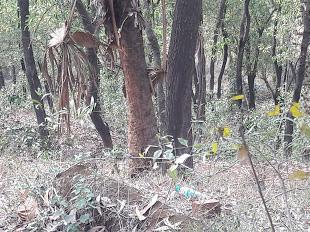Travel Tales Part 4
Gopegarh really came to its own after 5 PM. That was when
all the day-trippers departed and the entire park was left to us, the only two
boarders and the few staff who manned the canteen and looked after the park
proper. Imagine living in a wilderness of about 5 square miles, full of
forests, ravines and a lake and you are free to explore it at your own pace
with not another human in sight. I guess I now knew how the owners of landed
estates felt when they surveyed their domain.
 |
| Part of the forest |
The Forest authorities have created a trekking trail which
takes you through a fairly dense stretch of forest which has been left
relatively undisturbed. This short walk, perhaps a couple of kilometers starts
near the bungalow and ends up near the ruined fort and takes you down to the
gullies that have been carved out of the laterite soil by the Kangsabati river
and then up again to the sort of plateau I which most of the park is located.
Opposite to this is a lovely sal forest which offers leafy walks up to the
other end of the park, which however did not seem to be fenced. Consequently, as
we saw the next morning when we set out for an early walk, it is easy for local
tribals to enter and collect forest produce, which is Ok, but also to cut trees
and as we saw a family doing, which is not. There is a lake of sorts at that
end, now a little shorn of water, according to their website boating is
available, but we saw no signs of any such infrastructure. The land is
undulating, the sal forest giving way to a scrub jungle, all richly inhabited
by a profusion of bird species. It can be and perhaps is a much-prized bird watching
site. I managed to identify at least 30 odd species and I am not great at
identifying small forest birds. An expert could possibly have increased this
number quite substantially.
 |
| The Kangsabati |
 |
| Clouds built up |
One excursion that we made from the confines of the park was
to the Kangsabati River. Previously known as the Kasai (I wonder why?) it flows
gently through the plain a little way distant. We reached it by walking
through cultivated fields, all green thanks to the river and we reached it
just as the sun was being covered by ominous dark clouds. The clouds which
appeared out of nowhere at it seemed threatened to drench us in minutes and cut
short our excursion as we hurried back. Unfortunately, the rain caught up with
us as were striding through a village that adjoins the park and we were forced
to take shelter in a small under construction shed like structure until the
rain retreated. It was pleasant to watch the rain come down and trail off the
red laterite soil. Two young men joined us here; they were masons who had come
to Midnapur from Garbeta and on hearing that we were travelers, insisted that
we must see Gangani the so-called Grand Canyon of Bengal. I had already planned
that this would be one of our destinations, and their local pride piqued our
interest even more.
The rain had reduced temperatures considerably. And here, in
what may be described a forest, it was quite cold. Swapanda had recovered
fairly recently from a lung infection and I was worried that he may be affected
again. Consequently, we repaired to our room and sat out in the verandah and
watched the darkness fall. In a forest, darkness is accompanied by many
pleasurable experiences. The cicadas call, the owls begin to hoot and you can
hear much rustling in the undergrowth which you can imagine to be many unknown
creatures. Here, however, the darkness also heralded the buzzing of mosquitoes
so that we were forced into the room earlier than we would have liked.
However, we stepped out later to the dark wilds after the
rain stopped. The clouds had parted and the stars were out in their thousands.
Walking the paths of the park felt deliciously dangerous. God Knows what snakes
would appear? Or perhaps a jackal? In the event, we only heard the calls of
various night birds and returned to our room to a hearty meal of chicken curry
and roti cooked for us by the canteen boy.
The night passed uneventfully except that we were woken up once
by the calling of jackals. This is a sound that was ubiquitous in rural Bengal
in our younger days. In recent times it is almost never heard. The last time I
heard the calls was when I was living in the Lake Gardens’ Government Quarters.
There was a wasteland adjacent to it which housed a collection of jackals and
when times were right you could hear the sounds of this favourite denizen of
Bengali folk tales.
We woke early the next morning to explore our domain further and
debated whether we should stay here one night more. But restless travelers as
we are, the vote was for the road and so we returned to the bus station and
took a bus to Garbeta. The bus was crowded, though we were safely seated. The
route leads north past the Salboni forest and in a couple of hours we were at
Garbeta bus station. The route was pleasant, cultivated fields interspersed by
forest, mainly sal, but many teak trees as well. Now for the Grand Canyon.



Comments
plots for sale in chennai
plot for sale
flats for sale in chennai
sell home online in chennai
best real estate app in Chennai
house for sale in Chennai
best real estate apps
real estate app in India
real estate app
house for sale Buy Rent Lease in Chennai
real estate listing websites
Great story….Keep on sharing… Thanks